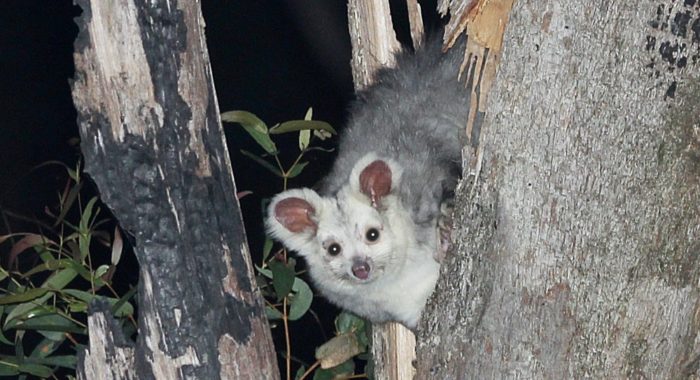
Greater gliders have been spotted in increasing numbers in the Kanangra-Boyd to Wyangala wildlife corridor in a new study by local ecologists.
It’s an encouraging sign the local population is recovering after the Black Summer bushfires, extreme heatwaves, and prolonged drought. A survey by the ecologists in 2020 estimated an alarming 60% decline of greater gliders in the region due to the combined impact of these threats.
In May and June 2022, ecologists Dr Judy Smith and Dr Peter Smith surveyed parts of Wombeyan and Jenolan for the Kanangra-Boyd to Wyangala (K2W) Conservation Partnership to monitor the post-fire recovery of gliders and other tree-dwelling mammals. The study was funded through GER’s partnership with WWF-Australia.
The ecologists discovered signs that the native marsupial had shown “surprising resilience”.
This year, for the first time, their research showed that greater glider numbers are increasing in parts of the bushland where some of their habitat had remained unburnt Indicating that recovery is underway in these areas.
However, greater gliders have disappeared from areas that burnt at high to extreme severity, where there was no live eucalypt foliage remaining in the aftermath of the fires. Sadly, there is still no sign of them recolonising these areas.
“Greater gliders feed almost exclusively on eucalypt leaves and the absence of live eucalypt foliage in the immediate aftermath of the fire (until epicormic foliage sprouted) would make the more severely burnt transects uninhabitable,” the researchers wrote in their report.
The program also assessed greater glider breeding success as the young from the 2021 breeding season had grown up and were out at night feeding, not sheltering in tree hollows.
Peter Smith said the population increase is possibly because of a successful breeding season in 2021 and the high rainfall over the last year which resulted in lots of the new, soft, nutritious eucalyptus foliage on which greater gliders selectively feed.
Outside the World Heritage Area, the Kanangra-Boyd to Wyangala corridor was less affected by the Black Summer fires. In the months after the bushfires, spotlight surveys and wildlife cameras showed that, despite a reduction in numbers because of the drought and heatwaves, the greater gliders had maintained a footing in the wildlife corridor. This corridor could offer an important refuge for the species to repopulate the Greater Blue Mountains World Heritage Area from.
In total, five species of arboreal mammal were recorded during surveys in 2022: the endangered greater glider, the vulnerable yellow-bellied glider, and three non-threatened species, the common brushtail possum, feathertail glider (broad-toed/narrow-toed feathertail glider) and sugar glider (Krefft’s glider)
Concerningly, three other arboreal mammal species recorded previously in the Wombeyan and Jenolan areas were not recorded in 2022, including two threatened species, the spotted-tailed quoll and squirrel glider, and one non-threatened species, the common ringtail possum.
A plethora of work is underway in K2W to help greater gliders and other wildlife to recover post-fire.



 Media release
Media release